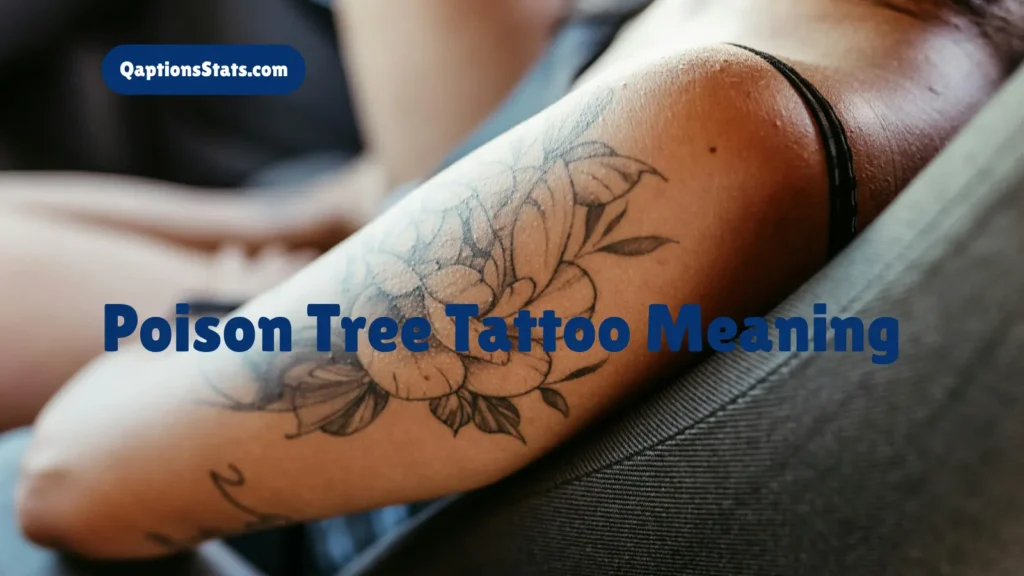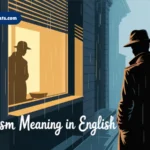A Poison Tree tattoo often draws inspiration from William Blake’s famous poem “A Poison Tree”, in which a speaker harbors anger until it becomes poisonous fruit. In tattoo form, it’s a powerful symbol of suppressed emotion, personal growth out of pain, and the long-term consequences of unresolved feelings. But artistic interpretations can go much further: twisting roots, entwined fruit, or even literal poison veining the tree can represent themes like emotional decay, healing, or the sharp contrast between inner turmoil and outward calm.
1. Literary and Symbolic Roots
William Blake’s poem uses the apple–tree metaphor: unexpressed anger grows into something dangerous. A tattoo influenced by this poem suggests:
- Bottled-up resentment
- Self‑destruction through suppression
- Warning against hidden anger
Choosing a tree trunk with dark veins or shadowed apples captures this blend of beauty and toxicity, making the tattoo visually and conceptually rich.
Related post: Voyeurism Meaning in English: Simple Guide & Examples
2. Interpretations in Tattoo Art

2.1 Suppressed Emotions
A Poison Tree tattoo can symbolize feelings kept inside. Tattoos showing dark fruit on a blossoming tree reveal how buried grief or frustration can affect overall wellbeing.
2.2 Transformation and Healing
Some artists depict the tree half-poisoned, half-regenerated—new branches shooting from gnarled roots of anger. This duality expresses recovery: pain leads to renewal.
2.3 Personal Warning
Ink that literally drips poison from its leaves can serve as an allegorical caution: unresolved anger can “poison” relationships and personal growth.
2.4 Defiance or Rebellion
For some, a stark, dramatic Poison Tree is a statement of empowerment—“I’ve survived my anger.” Bold color, edgy embellishments, or stylized roots can emphasize strength reclaimed.
Related post: Hakuna Matata Meaning in English
3. Components and Visual Variations
- Apples or fruit: bundled fruit can show explosive emotion about to break free. One single apple creates simplicity and focus.
- Roots and veins: tangled roots represent entrapment; clean roots hint at control or healing.
- Leaves: drooping leaves depict emotional fatigue; vibrant green ones suggest regeneration.
- Color schemes: dark reds, purples, and blacks evoke poison; greens with brown or gray show contrast and balance.
- Additional motifs: skulls, tears, shackles, or birds can personalize themes of loss, imprisonment, or liberation.
Placement matters too: a tattoo wrapping around the forearm feels vulnerable and visible; one on the back remains intimate and hidden.
4. Finding Your Meaning
- Reflect on your story: What anger or hurt did you bury?
- Decide your message: Is it an emotional warning, a step toward healing, or a claim of power?
- Choose symbols consciously: A stark black apple vs. a half‑bloomed one—each tells a different story.
- Ask your artist: A talented tattooist can help you refine details that balance visual appeal and symbolic resonance.
5. Cultural and Universal Themes
- Mythic echoes: Poison‑branded fruit calls Eden to mind—knowledge, disobedience, innocence lost.
- Alchemical links: Poison and transformation go hand in hand. Some embrace the idea that suffering forges wisdom.
- Psychological depths: A Poison Tree tattoo is rooted in human behavior—anger, repression, catharsis. It becomes a reminder, or even a personal talisman.
Read also: Medusa Tattoo Meaning
Hiatus Meaning
What Is a Hiatus?
Hiatus (noun) means a break or interruption in continuity, often temporary:
- A TV show goes on hiatus between seasons.
- A long distance runner may take a hiatus for injury recovery.
- A creative professional might take a hiatus from social media to refresh.
It originates from Latin hiātus, meaning “gaping opening.”
Nuances of Tone
- Neutral/Descriptive: “taking a brief hiatus”
- Formal: “entering a temporary hiatus”
- Casual: “on hiatus until next month”
A hiatus is purposeful and often positive—it signals planned pause, growth, and intentional break, not failure or neglect.
“Stand For” and “And” Meaning in Text
“Stand For”
“Stand for” can mean:
- Represent/denote
- What does that symbol stand for?
- What does that symbol stand for?
- Tolerate (usually with “won’t”)
- I won’t stand for rudeness.
- I won’t stand for rudeness.
- Support or advocate
- She stands for equal rights.
- She stands for equal rights.
Nuance: Use “stand for” to express representation, acceptance, or principle.
“And”
As a basic conjunction, “and” links words or clauses—but its power lies in how it sets tone:
- Neutral/Informative: “She writes poetry and prose.”
- Emphatic: “It was cold, and windy, and wet.” (repetition for effect)
- Conclusive/Final: “…and that’s why I left.”
Nuance: Rhythm and emphasis come from how you place “and.”
11 Examples: Alternatives for “Hiatus” in Context
Below are 11 polished, varied ways to express a pause, break, or temporarily stepping away, with tone and guidance:
- “Taking a short break” – Simple, casual.
- “Pausing operations for a moment” – Slightly formal, professional.
- “Entering a temporary pause” – Neutral, descriptive.
- “Currently on sabbatical” – Academic or creative connotation.
- “On a little downtime” – Relaxed, friendly.
- “Putting things on hold” – Works widely, from business to casual.
- “In transit mode” – Playful, modern: “I’m in transit mode—back soon.”
- “Undergoing a brief reset” – Emphasizes renewal, suitable for tech or digital.
- “In a temporary intermission” – Slightly theatrical, formal.
- “Offline for a while” – Casual, especially digital.
- “Stepping back for now” – Reflective, mindful tone.
Tone & Example Sentence for Each
- Casual:
- We’re taking a short break—back next week!
- Enjoy some downtime? I’ve scheduled mine next week.
- I’ll be offline for a while, but reach me by phone.
- We’re taking a short break—back next week!
- Professional/Neutral:
2. Our team is pausing operations for a moment to improve quality.
3. The project will enter a temporary pause from Friday.
6. We’re putting things on hold pending approval. - Formal/Creative:
4. After six years, she’s now on sabbatical to write her novel.
9. Enjoy the show’s intermission, please return in fifteen minutes. - Modern/Reflective:
7. I’m in transit mode for the next two weeks—catch me afterward.
8. The app’s servers are undergoing a brief reset overnight.
11. I’m stepping back for now to refocus and recharge.
Choosing the Right Phrase
- Identify your audience & context
- Work email? Use neutral/formal: “temporary pause.”
- Chatting with friends? Casual: “taking a short break.”
- Work email? Use neutral/formal: “temporary pause.”
- Set expectations clearly
- Add timing: “for two days,” “until next month,” “until further notice.”
- Add timing: “for two days,” “until next month,” “until further notice.”
- Signal intent
- Growth-oriented? Mention reset, sabbatical, or stepping back.
- Just pausing? “Putting things on hold” is fine.
- Growth-oriented? Mention reset, sabbatical, or stepping back.
Putting It All Together
A high‑quality article weaving these elements might flow:
- Open with poison tree tattoos—their symbolism and imagery.
- Clarify relevant terms, like hiatus, stand for, and and.
- Offer practical phrasing guidance, like the 11 examples above.
- Include polished examples in real‑life sentences.
- Wrap up by reminding readers how to choose tone‑appropriate language.
For instance:
“I’m currently on sabbatical to write my next book.” (creative, professional)
“We’ll be offline for a while, but you can still text me.” (casual, personal)
11 Stand‑Alone Examples (No Table, Simply Stated)
- I’m taking a short break to recharge—will return Monday.
- The team is pausing operations for a moment due to maintenance.
- We’re entering a temporary pause, resuming next Wednesday.
- After years of study, she’s on sabbatical to research abroad.
- I’m planning some downtime this weekend—see you soon!
- We’ve put things on hold until the board approves funding.
- I’m in transit mode this week—reach me mid‑next week.
- The platform is undergoing a brief reset, back shortly.
- Enjoy the intermission, please return in fifteen minutes.
- I’ll be offline for a while, but texts are welcome.
- I’m stepping back for now to refocus my priorities.
Recap: Why It Matters
- A Poison Tree tattoo is rich in symbolism: anger, hidden feelings, transformation.
- A hiatus signals a purposeful, often positive pause; best worded with tone-aware phrasing.
- “Stand for” carries meaning of representation, tolerance, or advocacy.
- “And” shapes tone—casual, emphatic, or conclusive based on rhythm.
- Providing varied and well‑contextualized alternatives empowers readers to choose the right expression.



